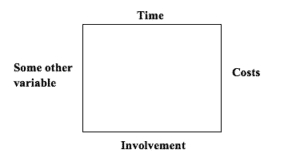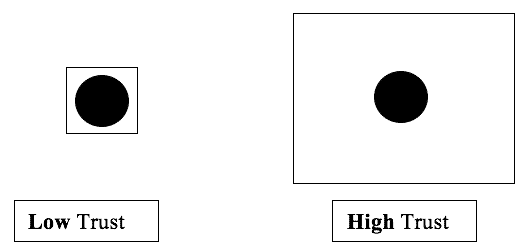— Put ‘em in a box and learn to say ‘yes’
I used to believe that empowerment and delegation were the same thing… that we just invented the term “empowerment” because so many managers sucked at delegating.
I was wrong. I try not to say that too often (just ask my family), but it’s a certainty here. I was wrong.
Let me give you my decidedly-non-textbook definitions of each, so we’re at least close to being on the same page. Those who know me know that I’m not about to wax on in some academic discourse. No, let’s keep it simple, shall we?
- Delegation: I take something—a task, usually—that I’m personally responsible for, and ask someone else to perform that task. They act in my stead.
- Empowerment: I give someone more control over the variables and operating decisions within their existing role. More control over their existing responsibilities.
If I ask you to prepare a report that I normally must do myself, I’m delegating. If I allow you to make decisions within your job that previously I made for you, I’m empowering.
See the difference? An oversimplification, I know, but it works.
Both sound pretty simple, and they really are. That doesn’t mean that we do either all that well, only that it’s not overly complex.
Delegation is easier than empowerment, though in my experience we don’t necessarily do it any better. We’ll discuss delegation some other time… today, it’s all about empowerment.
In my simplified world, empowerment has two distinct elements:
- The box
- Saying ‘yes’
Let’s first talk about the box. At Triangle Performance, we created the idea of The Box of Empowerment, where we put people in a box. That’s right—with all the hoopla about getting out of the box, we advocate putting people in the box, to clarify how we really empower over time. It’s slap-my-head simple, and most can understand it as an essential component. You see, we don’t do empowerment as all or none. We empower people in degrees.
First, you have one or more variables or decisions that are currently yours. Remember, by empowering someone, we’re enlarging their ability to perform their job. That job—their core responsibilities—are represented here by this dot:

Next, to understand the box, we must first know what empowerment is, and what it is not. It is increasing the general responsibility for decision-making over those things related to an employee’s current function or role.
It does not mean “self-employed.” In other words, when we empower someone, we do so with parameters around those newfound freedoms. For instance, we might empower someone to:
- Make any relevant decisions that do not cost more than $500.
- Choose any timing to complete within the next seven days.
- Work with anyone in our group to complete the job, except for Ted in Accounting. You can’t work with Ted (nobody likes him anyway).
In other words, your empowerment has boundaries. We call them parameters, and they are best represented by the box:

Now, if you lay that box over the employee’s core job or responsibilities, it looks something like this:

The dot represents the current job, as it is known today; the lines of the box represent the parameters (boundaries) you’ve provided as guidelines for the empowerment. The blue arrows, then, represent new decision-making latitude. The essence of empowerment.
Here’s where it gets important. We don’t empower everyone working for us in the same manner, or to the same degree. There are different levels of trust between leader and employee, and the box expands or shrinks with that trust, increasing or decreasing the latitude of decision-making based on evidence.

Here’s the crux: an empowered employee has complete personal discretion to make all decisions between the job (dot) and the box walls (parameters). If they need to exceed any of these parameters at all, they must come back to you for discussion and approval. Over time, you then decide whether to expand or contract the size of their box.
If an employee adapts well to the initial empowerment, you may expand the box, increasing his/her level of empowerment as your trust increases in their judgment.
If an employee fails or is unable to succeed with the new level of empowerment, you may want to contract or shrink the size of the box, lessening their ability (latitude) to make decisions beyond their core job.
The second element for empowerment is saying ‘yes.’
Confidence springs from success, and employees are much more likely to succeed if they get to do things their way, not yours. Most good employees (the ones you are empowering) don’t make really big fire-starting mistakes. Any errors tend to be nuance-like, and generally involve unexpected resource (usually time) costs, not some catastrophic meltdown.
A leader’s job, then, is to get comfortable—and better at—saying ‘yes.’ An employee asks you about a decision they need to make. You, the empowerment-focused leader that you are, ask the employee that great question, “What’s your recommendation?” Then, after listening carefully, you say “ok, let’s do that.” In other words, say yes.
Is their way the best? Maybe, maybe not. Do you know a better way? Maybe, maybe not. Have you “been there, done that?” Maybe, maybe not. It doesn’t matter… say yes. When they complete it, you can always go back and have another learning opportunity where you discuss how it went, and what they might consider doing in the future.
Employees appreciate the trust that comes from the unsaid “I likely know a better way, but I trust you’ll do the right thing.”
Over time, these events build trust. That increased trust translates into more empowerment from you. That increased empowerment means you can focus that same time on something more important, more strategic.
Or, you can go play golf, knowing the shop is in good hands, and likely won’t burn down before you return.
That’s the WIIFM, the What’s In It For Me, for you, in successful empowerment. Give it a shot.

